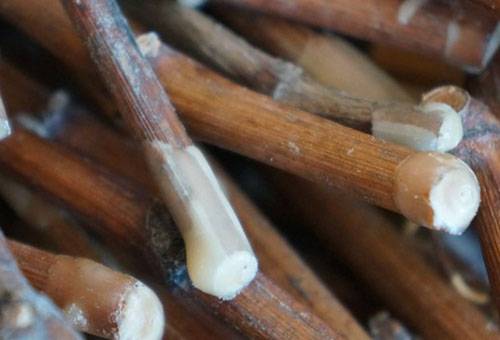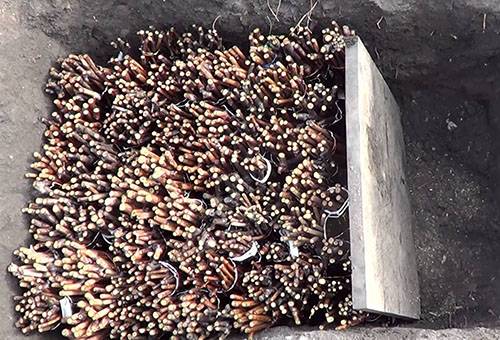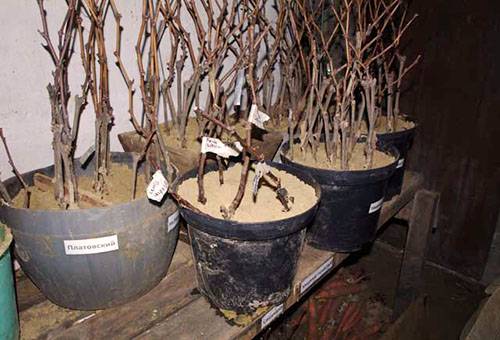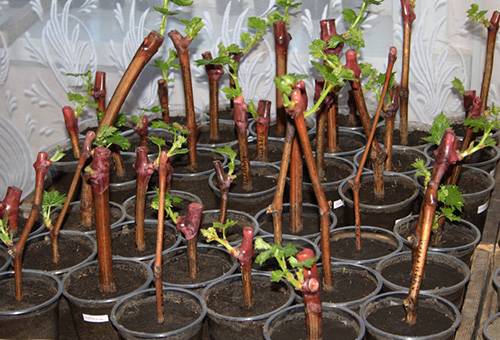How to save grape cuttings throughout the winter?
Grapes propagated by cuttings, planting them in the spring in the open ground or grafting. And here the question arises, how to store grape cuttings in winter. Saplings, they are also called chubuki, are a piece of vine with a pencil or pen thickness and a length of at least half a meter. It is important that at least 3-4 buds are present on the seedling, so that it grows well then. Why does propagation occur precisely by cuttings? Because when using seeds, many properties of varieties are not preserved, so you have to use the vegetative method.
Chubuk preparation
Cuttings are cut precisely in the fall, so as not to injure the mother vine that has come to life and has grown into growth in the spring. It will put in force to tighten the damage, and the fruit yield will be less. And in September-October, when all the processes in the plant have slowed down somewhat, pruning will not be so traumatic. Since at the same time the plant loses a lot of moisture, in the cuttings it is necessary to replenish its amount somewhat - make a fresh cut at one end and dip it in clean water. Subsequently, to prevent loss of liquid during storage, both ends are often dipped in molten paraffin. The optimal time for such gardening work is after the first small frosts, but before the temperature drops below -10 °.
In order for the chubuk to be well stored, and successfully taken up in the spring, it must be cut correctly. The lower or middle part of the young fruiting vine is selected. Both too thin and too thick shoots will not work. When trying to bend or break the shoot, it should crack slightly. The core should have a dense consistency, and the bark should have an even brown color without too light or dark spots. They cut the vine, retreating a few centimeters from the internode. Naturally, cutting tools must be clean and sharp.
Leaves and antennae that are not fallen on their own must be removed. The vine should not have mechanical damage and injuries, it is desirable that it be straight, because many gardeners argue that crooked cuttings take root much worse and are accepted in open ground.
Storage conditions
If we talk about the storage of grape cuttings, it is important to create the correct temperature and humidity conditions. Comfortable conditions for Chubuk - 0-4 ° С. At minus temperatures, they will freeze, and in excess heat, they can release roots and buds or become moldy and rot. The optimum humidity is about 60%. Excessive dampness is a favorable environment for the fungus, and in dryness the chubuki will lose too much water.
To protect against possible pests and diseases, the cuttings are sprayed or dipped in a weak solution of copper or iron sulfate. They can also be wiped slightly affected by mold during storage of the Chubuki. It is equally important to protect the grapes from being eaten by rodents - frequent guests in any basement or shed.
Where to keep chubuki in winter?
You can store cuttings wherever all the conditions for storage are provided. If there are few of them, then you can put it on the shelf of the refrigerator, wrapping the basal part with a damp cloth, and almost forget it until spring, only occasionally checking their condition and moisturizing the tissue. They won’t particularly disturb, they take up little space. Some make a simple and convenient container from two inserted into each other plastic bottles with cut bottoms and holes for ventilation in the lids.
And how to save grape cuttings in the winter, if there are a lot of them, and you can no longer limit yourself to a refrigerator? To do this, you need a whole room.Basement, cellar, extensive pantry - all this will do.
You can store grapes there as follows.
- Pour a suitable-sized container (bucket, drawer, basin, even an old bath) with a clean and slightly moistened sand layer of 10-15 cm. Next, cuttings must be stuck in the sand so that they do not touch each other. Since the upper part of the seedling will remain visible, throughout its shelf life it will be possible to assess its condition and health. The moisture content of the sand must be maintained constantly. This is easier to do if the container is covered with polyethylene.
- Instead of sand, sawdust is used, most often coniferous, because they contain substances that impede the development of the fungus, or moss. Such a substrate must also be kept moist.
- If there is no basement, but you need to store a lot of grapes at once, then for this a trench digs a meter deep and 60–70 cm wide. Its walls are impregnated with lime for disinfection, then a small layer of sand is poured, on which seedlings are individually or horizontally laid horizontally or vertically in small bunches. The gaps between them are also covered with sand. It is necessary to sprinkle a small amount of soil on top to make a mound that will protect the buried grapes from excessive moisture, especially in spring. For the same purpose, the soil can be additionally covered with polyethylene. However, the trench is still not safe from flooding, and the appearance of rodents there is completely impossible to track or prevent. In addition, the Chubuki are completely in the ground, and it is not possible to verify their safety.
Tip
If several grape varieties are stored at the same time, they must be located separately from each other.
Spring seedlings care
How to understand that the grapes have successfully wintered and are ready to grow? Small buds of leaflets should appear in the eyes, and there will be a green layer under the bark. And when the chubuk is put into the water for several days, the kidneys are distinctly swollen.
Prepare cuttings for planting should be in late winter - early spring. To do this, they must first be rooted. The easiest way to do this is by sticking the basal part into the raw foam and removing the seedlings in a dark place for 1-2 weeks. During this time, at least small roots must be pecked. Then they are usually planted in the trimmed lower part of the plastic bottles in the soil with a copious content of humus, covered with the upper part of the bottles (but without the lid) and put in a lighted place. When there are many roots and 4-5 leaves, the upper part can be removed.
Grown bushes of grapes are planted in open ground in the early to mid-summer. Naturally, the vine needs to be provided with all the conditions required for its variety, and the soil must be loosened regularly, providing air access to the root system, fed with mineral fertilizers and watered. It is important not to damage the roots when planting, because in this case, the chubuk will have few chances to take root and give a good harvest. And with a favorable set of circumstances and compliance with all requirements, by the fall, the plant will delight with powerful roots and healthy strong shoots.
We recommend that you read the article on how to care for the arrowroot at home




I really liked the article. Simple and affordable even for novice agricultural lovers. Three times in five.